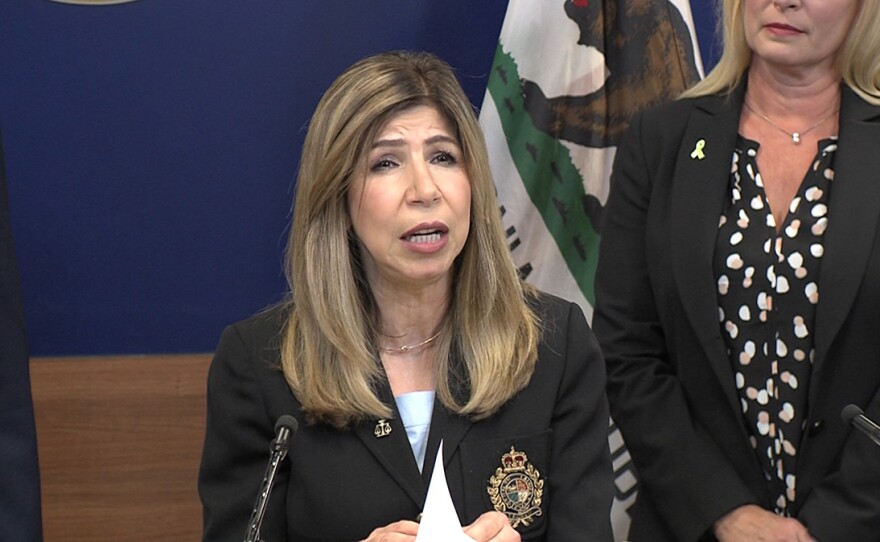The San Diego County District Attorney's Office announced Wednesday it has cleared local law enforcement officers involved in four shootings — two of which were fatal — and one in-custody death, dating back to June of 2019.
The District Attorney's Office released its reports and video footage regarding the actions of eight officers, and in each case stated that the officers' actions were justified and resulted in no criminal liability.
Among the fatal incidents was the Aug. 24, 2019, shooting of 52-year-old Dennis Carolino by San Diego Police Officer Brad Keyes in the El Cerrito neighborhood.
The DA's Office said in a letter to SDPD Chief David Nisleit that Carolino charged at Keyes and another officer with a shovel.
Police were initially called to the scene for reports that Carolino — who witnesses said suffered from schizophrenia and had not been taking his medication —had thrown a brick at his aunt, the DA's Office said.
As the officers approached a shed on the property where Carolino lived, the shed door "suddenly opened" and Carolino ran at the officers while wielding the shovel.
While Keyes' partner fired a stun gun, "it was ineffective at stopping Carolino," the DA's Office said, leading Keyes to fire multiple times, killing Carolino.
The DA's Office said both officers used their weapons to defend themselves and civilians, and that "Carolino indicated by his behavior that he was willing and attempting to assault and cause harm to both officers."
The second fatal shooting included in the reviews was the Jan. 24 shooting of Toby Diller, who the DA's Office alleges grabbed an officer's gun from his holster just prior to being shot and killed by Officer Devion Johnson.
The DA's Office said Diller, 31, was contacted for holding an open alcohol container, then fled on 54th Street, prompting a foot chase.
Officers tackled Diller to the ground, where a "violent struggle ensued," in which the DA's Office alleged Diller grabbed the holstered gun from an officer's duty belt.
That officer said, "He has my gun, shoot him," and Johnson fired a shot at Diller's left cheek. He was pronounced dead at the scene.
The DA's Office said, "it is objectively reasonable that an officer in the same situation would have reason to believe that there was an imminent threat of death or serious bodily harm, not only to himself, but to his partner."
Diller's family has since filed a federal lawsuit against the city of San Diego, Johnson and his partner, alleging wrongful death and arguing that Diller did not in fact have possession of the officer's gun.
Three San Diego police officers were also cleared regarding the arrest and subsequent in-custody death of 40-year-old Buddie Nichols on June 11, 2019.
Police were initially called to the scene of a home burglary, in which a resident called police to say a man had broken into his home.
Officers identified only as T. Davoren, B. Kashouty and S. Springer in a DA's letter to Nisleit arrested Nichols, though "it took all three officers to handcuff Nichols," who the DA's Office said appeared to be under the influence of a controlled substance and was "screaming and thrashing about with his body" during the arrest.
Paramedics later arrived, at which time "the officers noticed Nichols appeared to be unconscious." He was taken to UCSD hospital, where he was pronounced dead.
The medical examiner concluded Nichols' death was accidental and his cause of death was "resuscitated arrest due to sudden cardiac arrhythmia due to excited delirium while intoxicated on methamphetamine," the DA's Office said.
The medical examiner also noted Nichols had "numerous blunt force injuries to his head, face, torso and extremities," as well as "fractures to his ribs and sternum," but concluded "these injuries did not contribute to Nichols' death."
Officers were also cleared in two non-fatal shootings that occurred in El Cajon and San Diego.
El Cajon Police Officer Brandon Stanley was cleared in the Feb. 12 shooting of Keith Crenshaw, which was described as an attempted "suicide by cop" by the District Attorney's Office.
The DA's Office stated that police initially were investigating a report of a stolen vehicle, which was located in El Cajon via a license plate reader hit.
Crenshaw was found sleeping inside the vehicle and was met by Stanley and other officers.
Though Crenshaw was unarmed, he kept his hands concealed in his clothing as officers commanded him to remove his hands and told the officers, "Shoot me," according to the DA's Office.
After making several "jolting and jerking movements towards Stanley through the open passenger door," Stanley fired twice, striking Crenshaw in the chest and arm.
The District Attorney's Office said Crenshaw later "explained that he was suicidal and wanted the officer to believe that he had a gun."
The DA's Office found that "Stanley's belief was reasonable considering Crenshaw's failure to show his hands despite officer commands and Crenshaw's movement towards his waistband while Crenshaw made sudden, quick movements towards Stanley as if Crenshaw had a firearm."
The other non-fatal shooting occurred on Feb. 27, in which 70-year-old Carlos Soto was shot three times after the DA's Office says he grabbed a gun from his jacket as officers were telling him get on the ground.
San Diego police officers Jeremy Huff and Filip Perry encountered Soto at a homeless encampment in the Otay Valley Riverbed Park.
When they saw Soto, the officers saw a gun — later determined to be an air pistol — in Soto's jacket pocket.
After the officers commanded Soto to get on the ground, he reached for the gun, leading Huff and Perry to shoot him in the arm and leg.
Soto told investigators later that he wanted to put the gun on the floor "so that officers could see it was not real," according to the DA's Office.







